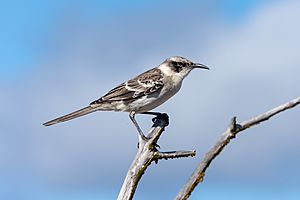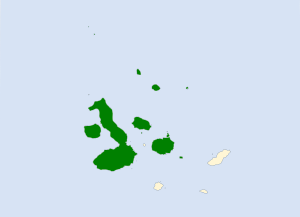Galápagos mockingbird facts for kids
Quick facts for kids Galápagos mockingbird |
|
|---|---|
 |
|
| On Genovesa | |
| Conservation status | |
| Scientific classification | |
| Genus: |
Mimus
|
| Species: |
parvulus
|
 |
|
| Synonyms | |
|
|
The Galápagos mockingbird (Mimus parvulus) is a special type of bird that lives only on the Galápagos Islands in Ecuador. It is part of the Mimidae family, which includes other mockingbirds.
Contents
How Scientists Name and Group Them
The Galápagos mockingbird is one of four types of mockingbirds found only on the Galápagos Islands. These four birds are very closely related. Scientists believe they all came from one ancestor bird that arrived on the islands a long time ago.
When John Gould first described this bird in 1837, he used specimens (samples) brought back by Charles Darwin. He named it Orpheus parvulus. But because of naming rules, the name Orpheus was changed. In 1841, George Robert Gray moved these birds to an older group called Mimus. Later, in 1890, Robert Ridgway created a new group, Nesomimus, just for the Galápagos mockingbirds. Most scientists used this new name for a while.
However, recent studies of bird DNA show that the Nesomimus mockingbirds actually fit well within the original Mimus group. So, many scientists have moved them back into the Mimus group.
There are six different types, or subspecies, of the Galápagos mockingbird. Each subspecies lives on a specific island or group of islands:
- M. p. barringtoni lives on Santa Fé.
- M. p. bauri lives on Genovesa.
- M. p. hulli lives on Darwin.
- M. p. parvulus lives on Santa Cruz, North Seymour, Daphne Major, Isabela and Fernandina.
- M. p. personatus lives on Pinta, Marchena, Rábida and Santiago.
- M. p. wenmani lives on Wolf.
The name Mimus comes from a Latin word meaning "mimic" or "imitator." The species name parvulus is also Latin and means "very small."
What Does It Look Like?
Like other Galápagos mockingbirds, this species has a long tail and fairly long legs. Its beak is long, thin, and curves downwards. The Galápagos mockingbird has a white stripe behind its eye. It has dark brownish-black patches near its eyes and ears, and a wide white band around its neck.
Its head is dark brown, and its upper body is grayish-brown with darker brown stripes. The feathers used for flying are dark brown and have two white bars. Its underside is whitish, with a few brownish streaks on its chest and sides. The bird's eyes are yellowish, and its beak and legs are black.
Where Do They Live?
The Galápagos mockingbird is the most common mockingbird species on the Galápagos Islands. You can find it on most of the larger islands and many of the smaller ones in the archipelago.
Behavior
What Do They Eat?
The Galápagos mockingbird eats many different things, just like other mockingbirds on the islands. It is an omnivore, meaning it eats both plants and animals. Its diet includes seeds, insects, eggs, baby turtles, and even placentas from Galápagos sea lions.
Scientists have found that this bird might help spread invasive plant species across the islands. It eats more fruit than some other birds, like Darwin's finches. The seeds that pass through its body can still grow into new plants.
Protecting the Galápagos Mockingbird
Studies show that a bird disease called avian poxvirus causes many nesting failures for Galápagos mockingbirds on Santa Cruz Island. Young birds seem to get sick more easily than adults and often die if infected.
Also, tiny larvae of a fly called Philornis downsi can attack baby mockingbirds in their nests. This fly was accidentally brought to the Galápagos. These infestations often lead to the death of young birds. The Galápagos mockingbird can also host several types of biting lice. Mockingbirds from Genovesa Island can carry a parasite called Polysporella genovesae in their intestines.
Even though it lives in a relatively small area and its exact numbers are not known, the Galápagos mockingbird is described as "common." Its population seems to be stable. Because of this, the International Union for Conservation of Nature lists it as a species of Least Concern, meaning it is not currently at high risk.
The entire area where these birds live is part of the Galápagos National Park, which helps protect them. However, like all native wildlife on the islands, they face some possible dangers. These include changes to their habitat from animals eating too much grass (overgrazing), predators (animals that hunt them) that were brought to the islands, and fires.
Gallery
See also
 In Spanish: Sinsonte de Galápagos para niños
In Spanish: Sinsonte de Galápagos para niños




